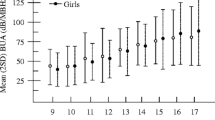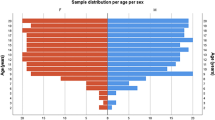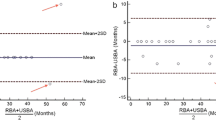Abstract:
We investigated the quantitative ultrasound (QUS) parameters broadband ultrasound attenuation (BUA) and speed of sound (SOS) measured in the posterior part of the calcaneus at the region of interest (ROI) with the lowest attenuation, using an ultrasound imaging device (UBIS 3000) in 491 healthy Caucasian children and adolescents (262 girls, 229 boys) between 6 and 21 years old. The relation of age, body weight, height, foot dimensions and pubertal stage to BUA and SOS was assessed. BUA increased nonlinearly with age in boys and girls, r 2 being 0.44 (p<0.001) and 0.57 (p<0.001), respectively. SOS increased linearly with age in girls (r 2= 0.04, p<0.001). There was no significant increase in SOS in boys (r 2= 0.01, p>0.05). Heel width was significantly correlated with BUA (r= 0.20, p<0.005 in boys; r= 0.27, p<0.05 in girls) and with SOS (r=−0.19, p<0.005 in boys; r=−0.08, p<0.05 in girls). After downward adjustment of the ROI size according to foot length quartiles, significantly lower BUA and SOS values were found compared with those with the standard ROI size of 14 mm. After correction for heel width and adjustment of the ROI size based on foot length, BUA and SOS were significantly associated with age in boys (r 2= 0.36, p<0.001 and 0.06, p<0.05) and in girls (r 2= 0.53 and 0.06, both p<0.001). Tanner stage was significantly correlated with BUA (r= 0.62, p<0.001 in boys; r= 0.73, p<0.001 in girls) but not with SOS. BUA but not SOS increased significantly with the number of years since menarche (p<0.001). In a multiple stepwise regression analysis in boys, age, weight and foot length were independent predictors for BUA, and age and foot length for SOS. In girls, age and weight were independent predictors for BUA and age was the only independent predictor for SOS. After correction for age, pubertal stages and heel width were no longer determinants for QUS parameters in either boys or girls. In conclusion, BUA increased significantly with age in both sexes. SOS increased with age in both boys and girls, but the increase was small and not statistically significant in boys. SOS, as measured with the UBIS 3000 device, may therefore not be appropriate to assess skeletal status in healthy children. Whether SOS and BUA are affected in children with skeletal disorders has yet to be determined. In boys, age, weight and foot length were independent predictors for BUA and age and foot length for SOS. In girls, age and weight were independent predictors for BUA and age was the only independent predictor for SOS. In our opinion, children with small feet should be measured with a smaller ROI diameter than those with larger feet.
Similar content being viewed by others
Author information
Authors and Affiliations
Additional information
Received: 28 October 1999 / Accepted: 19 June 2000
Rights and permissions
About this article
Cite this article
van den Bergh, J., Noordam, C., Özyilmaz, A. et al. Calcaneal Ultrasound Imaging in Healthy Children and Adolescents: Relation of the Ultrasound Parameters BUA and SOS to Age, Body Weight, Height, Foot Dimensions and Pubertal Stage . Osteoporos Int 11, 967–976 (2000). https://doi.org/10.1007/s001980070036
Issue Date:
DOI: https://doi.org/10.1007/s001980070036




